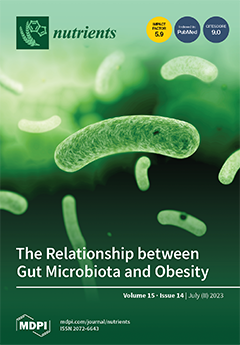Sugar intake has been linked to the global rise in diabetes. However, the unique diabetogenic effect of sugar, independent of weight gain, remains controversial. This study aimed to investigate the associations between total and added sugar intake and diabetes status, and to test
[...] Read more.
Sugar intake has been linked to the global rise in diabetes. However, the unique diabetogenic effect of sugar, independent of weight gain, remains controversial. This study aimed to investigate the associations between total and added sugar intake and diabetes status, and to test whether the sugar–diabetes associations were moderated or mediated by the body mass index (BMI). We performed a nationwide cross-sectional study on 12,889 Chinese adults who were enrolled in the China Health and Nutrition Survey (CHNS) 2011. The data for the total and added sugar intake were measured using three consecutive 24 h recalls, and determined based on the U.S. Department of Agriculture (USDA) National Nutrient Database for Standard Reference, Release 28 (SR28), the Food Patterns Equivalents Database (FPED) 2015–2016, and the labeled ingredients and nutrient contents. A multivariable logistic regression model was used to analyze the associations between the total and added sugar intake and diabetes. A nutrient density model was used to adjust for the total energy intake. A mediation analysis for significant sugar–diabetes associations shown in multivariable logistic analysis (
p < 0.05), and a subgroup analysis according to the BMI category were performed, to examine the mediating and moderating effects of the BMI on the sugar–diabetes association, respectively. We included 12,800 individuals, with a mean age of 50.5, in the final analysis. The means of the total and added sugar intake, total sugar (%E), and added sugar (%E) were 28.2 ± 0.2 g/d, 5.0 ± 0.1 g/d, 6.0 ± 0.0%, and 1.0 ± 0.0%, respectively. The overall prevalence of self-reported physician-diagnosed diabetes was 4.0%. A significant association between the total sugar intake and an increased risk of diabetes was found (odds ratio [OR] =1.008, 95% CI 1.001–1.016). The mediation analysis showed a significant mediation effect through the BMI of the effect of the total sugar on diabetes status (
p < 0.001), where 11.7% (95% CI: 4.7–35.7%) of the effect of the total sugar on diabetes was mediated through the BMI. The total sugar intake had a significant direct effect on diabetes around the BMI (estimated coefficient = 0.0004,
p < 0.001). The overall total-sugar-intake–diabetes association remained significant in normal-weight participants in the subgroup analysis (OR =1.012, 1.000–1.024). In conclusion, although the BMI moderated and mediated the association between the total sugar intake and diabetes, the total sugar still showed some unique weight-independent diabetogenic effects. Our findings call for efforts to prevent and control diabetes by reducing sugar intake, and losing weight appropriately.
Full article


